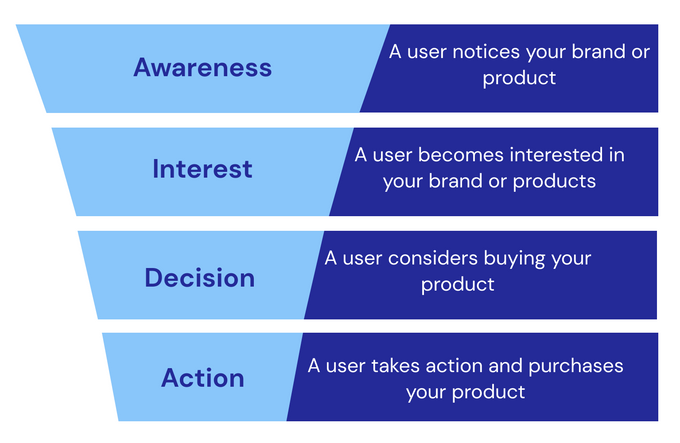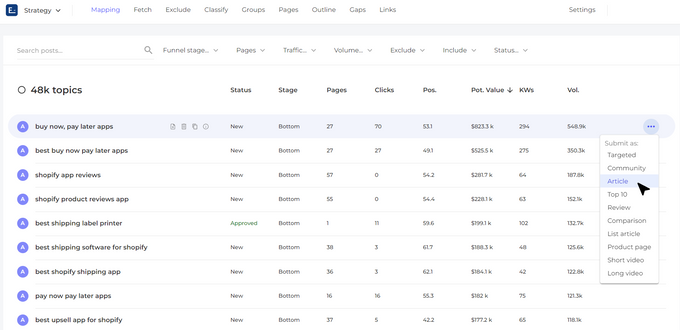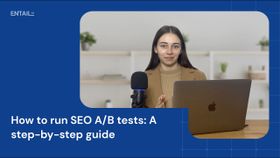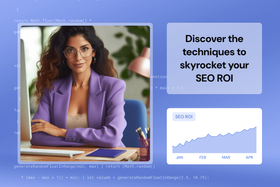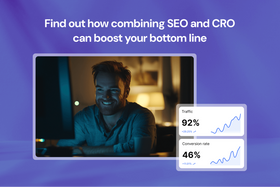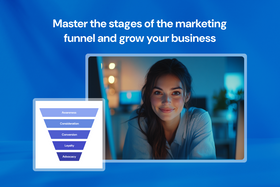Guide to sales funnels: Using AI to maximize reach and conversions
Learn what the sales funnel is, how to use it, and how to make your funnels more accurate and effective.
Updated February 20, 2025
Any business looking to thrive needs an optimized sales funnel. The effectiveness of your sales funnel depends on how well it meets the expectations of consumers who have endless options at their fingertips. This article explores the intricacies of the sales funnel and offers insights into how you can build and refine your funnels to better guide potential customers to conversion.
Key takeaways
- The sales funnel is a way to describe the stages of the user journey.
- Map relevant topics per funnel stage to optimize the user journey.
- Use AI to map multiple funnels to increase reach and conversions.
- Personalize funnels to cater to different personas, needs, etc.
What is the sales funnel?
A sales funnel describes the journey users take when buying a product—from becoming aware of the product or brand to deciding to purchase.
Sales funnels are usually broken down into four stages:
- Awareness: Users notice your brand or products.
- Interest: Users become interested in your brand or products.
- Decision: Users are considering whether to buy your product.
- Action: Users take action and purchase your product.
» Talk to an SEO expert about building a sales funnel for your business.
Example of the sales funnel in B2C and B2B
Let’s use Upstep, a company that sells custom orthotics, to illustrate the B2C sales funnel.
Say you’re experiencing foot pain and suspect it could be plantar fasciitis. As you search for information, you come across an Upstep video that thoroughly explains plantar fasciitis, its symptoms, and various exercises to alleviate discomfort. The video also introduces Upstep’s custom orthotics as a potential treatment option. Through this interaction, you become aware of Upstep.
Curious about Upstep and their products, you decide to visit their website, where you find detailed information about their custom orthotics for plantar fasciitis. Your interest grows, and you begin considering Upstep’s product as a solution to your problem.
Convinced by the information on the website, you decide to take action and buy Upstep’s custom orthotics. By making this purchase, you complete your journey through the sales funnel.
While the B2B sales funnel is similar, it's often longer and more complex because:
- There's more than one decision-maker involved in the purchase decision.
- B2B products are usually more expensive.
- The user journey is often longer as prospects need to learn more about your offerings to fully understand the product and make an informed decision.
Sales funnel vs. user journey
The terms "sales funnel" and "user journey" both refer to the process through which a potential customer becomes aware of and purchases a product. However, there's a slight difference.
The user journey includes the complete experience and interactions a customer goes through, from identifying a problem (like foot pain) to considering and buying a solution (such as orthotics). The sales funnel, on the other hand, categorizes these steps into the stages of the buying process: awareness, interest, decision, and action.
How to create a sales funnel
To effectively build a sales funnel, you need to map your topics to every stage. Then, create content that strategically guides users through these stages. By doing so, you can engage customers at every point in their journey and maximize the chances of conversion.
Start at the bottom of the funnel
At Entail, we start by mapping topics at the bottom of the funnel where the user makes the purchase decision. Even though lower volume and higher competition make it more difficult to rank, this is the most important part of your funnel because it’s where you get conversions. Starting at the bottom can also help you understand and map the stages that come before more easily.
Let's say you sell content strategy software. Users at the bottom of the funnel have already gone through all the other stages, so all you need to do is give them a final nudge toward conversion.
Bottom-of-the-funnel content includes your:
- Homepage
- Feature pages
- Product pages
- Category pages
- Solution pages
This is how you start your funnel, but it's rarely enough. These pages target very competitive topics and usually won't get much organic traffic as a result. You need to build out the rest of your funnel with high-quality content on relevant topics.
Move to the interest and decision stages
At this stage, you want to provide the user with solutions to the problems they’re trying to solve. So, you need to understand the considerations of someone interested in your product.
In the case of our content strategy example, users at this stage of the funnel may be interested in topics such as how to create a content strategy, how to select topics, etc. Then, you can position your product as the solution to their problem. This stage usually has more volume and less competition than the bottom of the funnel, making it easier to rank.
End with the awareness stage
Users at this stage don't know they need your product yet, but you can use this opportunity to get on their radar and drive them into your funnel. There's less competition because the conversion rate is lower, so you'll have more relevant topics to choose from.
To go back to our example, users at this stage may want to know why they need a content strategy or new content marketing techniques. So, you can create informational content to provide an explanation.
Use AI to map sales funnels
If you look deeper into your sales funnel, you'll find sub-funnels within the main funnel. Take Entail's SEO software, for example. Its features include topic selection, keyword grouping, content strategy, crawl stats, and keyword cannibalization. So, someone interested in keyword cannibalization belongs to a sub-funnel of the larger SEO software funnel. The challenge for businesses is mapping these sub-funnels effectively, but you can use AI to help.
Start by defining your marketing goals. The more detailed you are when defining them, the more targeted your funnels will become. For example, your overall objective might be to sell orthotics, but more specific goals could include selling orthotics for flat feet or orthotics for runners with flat feet. Each funnel goal should also include the relevant topics and the value of a goal completion.
Once you've defined your marketing goals, Entail’s AI-powered content strategy software can automatically map out all the relevant topics for each and build the associated funnels. This includes determining which topic belongs at each funnel stage for every specific goal. It allows you to target multiple users interested in different topics, ensuring their journey on your website leads them to the right destination.
» Book a consultation to build a sales funnel that converts.
How to leverage sales funnels in your marketing
You might be familiar with the basic concept of a sales funnel, but the real challenge is leveraging it effectively within your business. How do you take it to the next level?
The most important thing is personalizing your offering to align with each user's specific funnel at scale. You need to understand who the user is and what solutions or benefits they’re looking for. This way, you can cater to specific intents, making your funnel more accurate and effective.
For that, you need to build multiple funnels for each benefit a user is seeking or every intent they may have. This is the best approach to using the sales funnel in your marketing. You can apply it across your SEO strategies, paid campaigns, and even social media content.
How to measure sales funnels and optimize content across multiple channels
To effectively measure and optimize advanced sales funnels, you must measure their performance across different marketing channels.
SEO channels
For organic traffic, specifically articles, focus on measuring the traffic and engagement of each content piece. This can be extremely difficult since a funnel can involve multiple steps and paths to goal completion. Not all content directly contributes to conversions; some may simply lead users from one top-of-funnel piece to another. Therefore, you need to be able to measure the value of each piece of content by the level of engagement.
» Check out more metrics and KPIs for each stage of the SEO funnel.
Social media channels
In social media, the value of engagement varies. A comment might be worth more than a share, and engagements on bottom-of-the-funnel content are more significant than at the top of the funnel. Here, you would need to factor in the engagement metrics (e.g., likes, comments, shares, and saves) and funnel stage to really understand the engagement value of every content piece.
Because this is almost impossible to do across many pieces of content, you may want to use analytics tools. Entail’s conversion rate optimization (CRO) software can help you measure engagement and the impact of your sales funnels across multiple content pieces on your website.
Once you know the engagement value, you can optimize your content. If it's an article, you would measure how much traffic you're getting and which items are getting clicks, and then optimize them to get more valuable clicks. For example, clicking "book a demo" is more impactful than clicking "learn more" or just navigating to another article.
Maximize conversions with the sales funnel
Using the sales funnel effectively means understanding that potential customers go through the same funnel stages, even if they arrive through different channels and user journeys. By mapping out your funnels and strategically creating content for every stage and channel, you can capitalize on the sales funnel approach and drive conversions.
READ MORE: The 5 stages of the marketing funnel explained
